Now Reading: Nanoplastics Dominate Ocean Pollution: Study
-
01
Nanoplastics Dominate Ocean Pollution: Study
Nanoplastics Dominate Ocean Pollution: Study

Speedy Summary
- Nanoplastics, particles smaller than a human hair, are pervasive in the ocean and can pass through cell walls, entering food webs.
- Research reveals 27 million metric tons of nanoplastics concentrated in the top layer of the north Atlantic Ocean.
- The primary types found include polyethylene terephthalate (PET), polystyrene (PS), and polyvinylchloride (PVC), detected at average concentrations of 18 milligrams per cubic meter across sampled depths.
- The study excluded polyethylene (PE) nanoplastics likely due to rapid chemical transformations or sinking mechanisms.
- Researchers used thermal-desorption proton-transfer-reaction mass spectrometry for detection during sampling across 12 locations at varied depths in the North Atlantic in November 2020.
- Nanoplastics pose a notable threat within marine ecosystems by infiltrating phytoplankton-key components of the food web-allowing them to spread throughout living cells globally. This highlights their greater toxicological risk compared to microplastics.
- Negotiations for a legally binding United Nations treaty on plastic pollution are set for August, with proposals to limit future plastic production facing resistance from oil-exporting states.
Indian Opinion Analysis
The mounting evidence about nanoplastics depicts an alarming situation that transcends regional boundaries, demanding global attention. India’s reliance on oceanic ecosystems-for fisheries, biodiversity conservation, and climate regulation-is particularly vulnerable to this crisis. If these particles compromise marine food chains globally, india may face economic impacts within fishing industries and agricultural sectors reliant on coastal resources.
The ongoing UN negotiations signal an possibility for India’s active participation in advocating collaborative international measures aimed at curbing plastic pollution. However, tackling this issue domestically requires enforcing robust waste management policies while promoting alternatives like biodegradable packaging materials.
India’s current efforts need alignment with scientific advancements demonstrated by studies like these-to monitor invisible pollutants such as nanoplastics actively-and integrate data-driven environmental policies proactively into developmental plans.

























